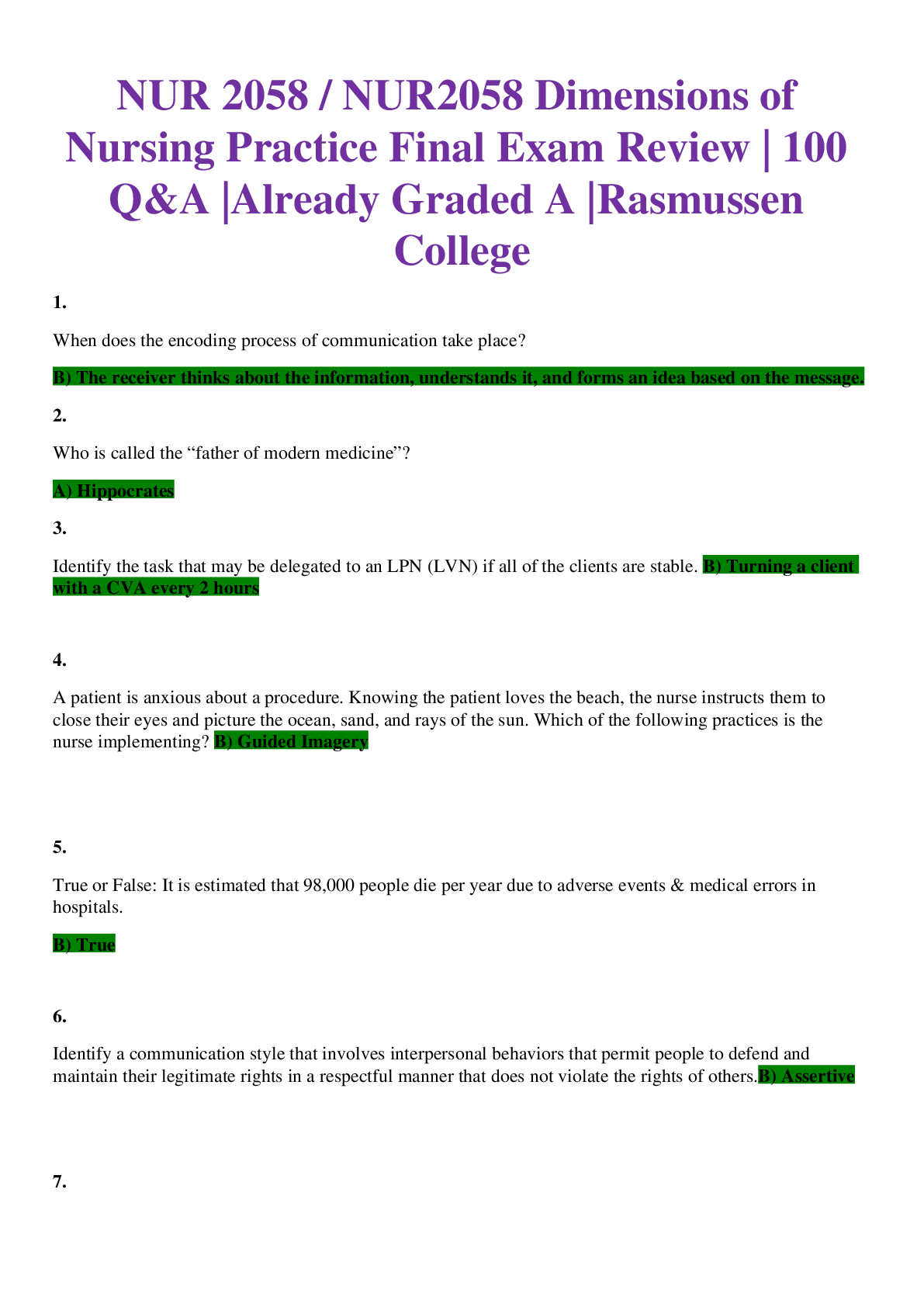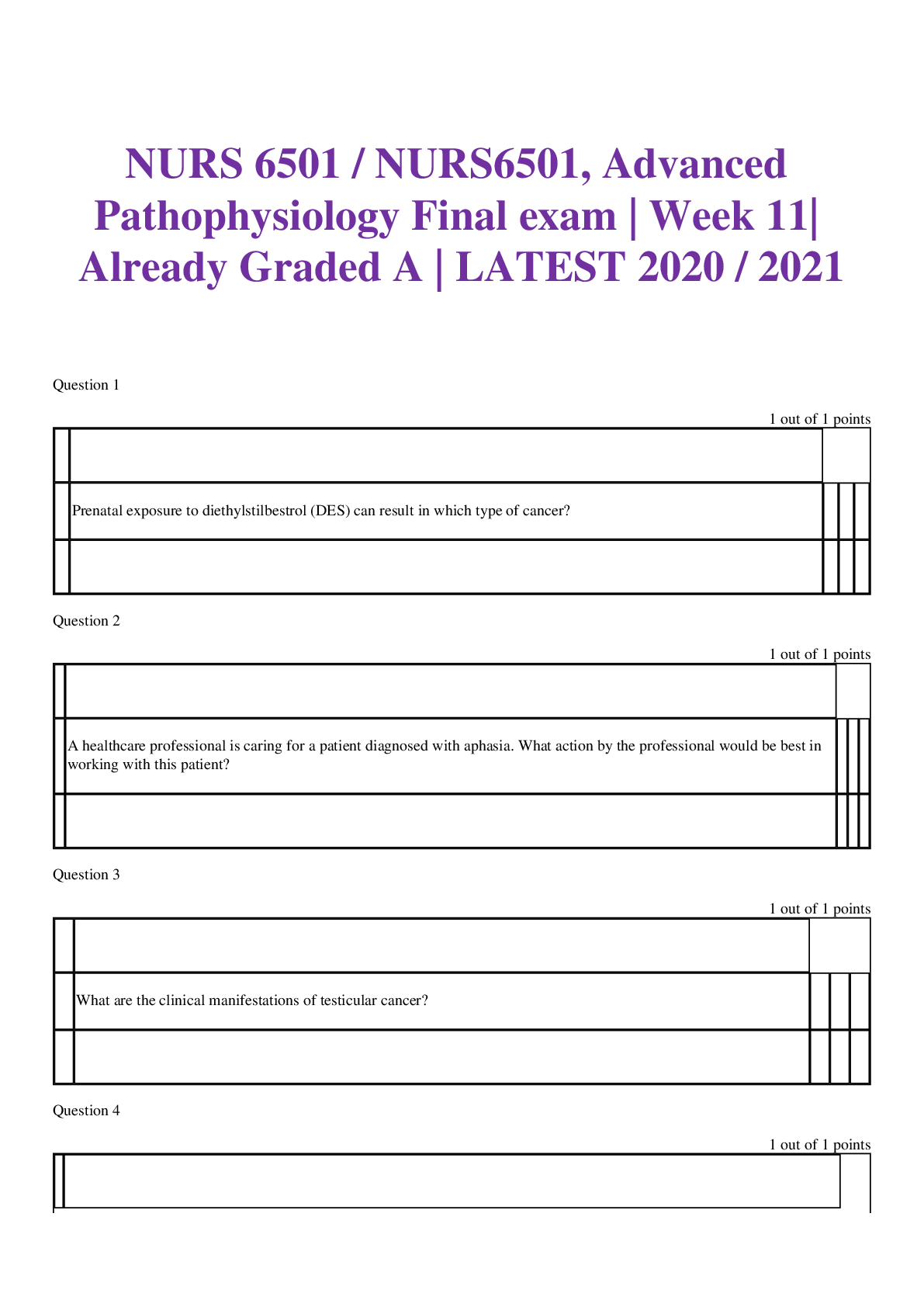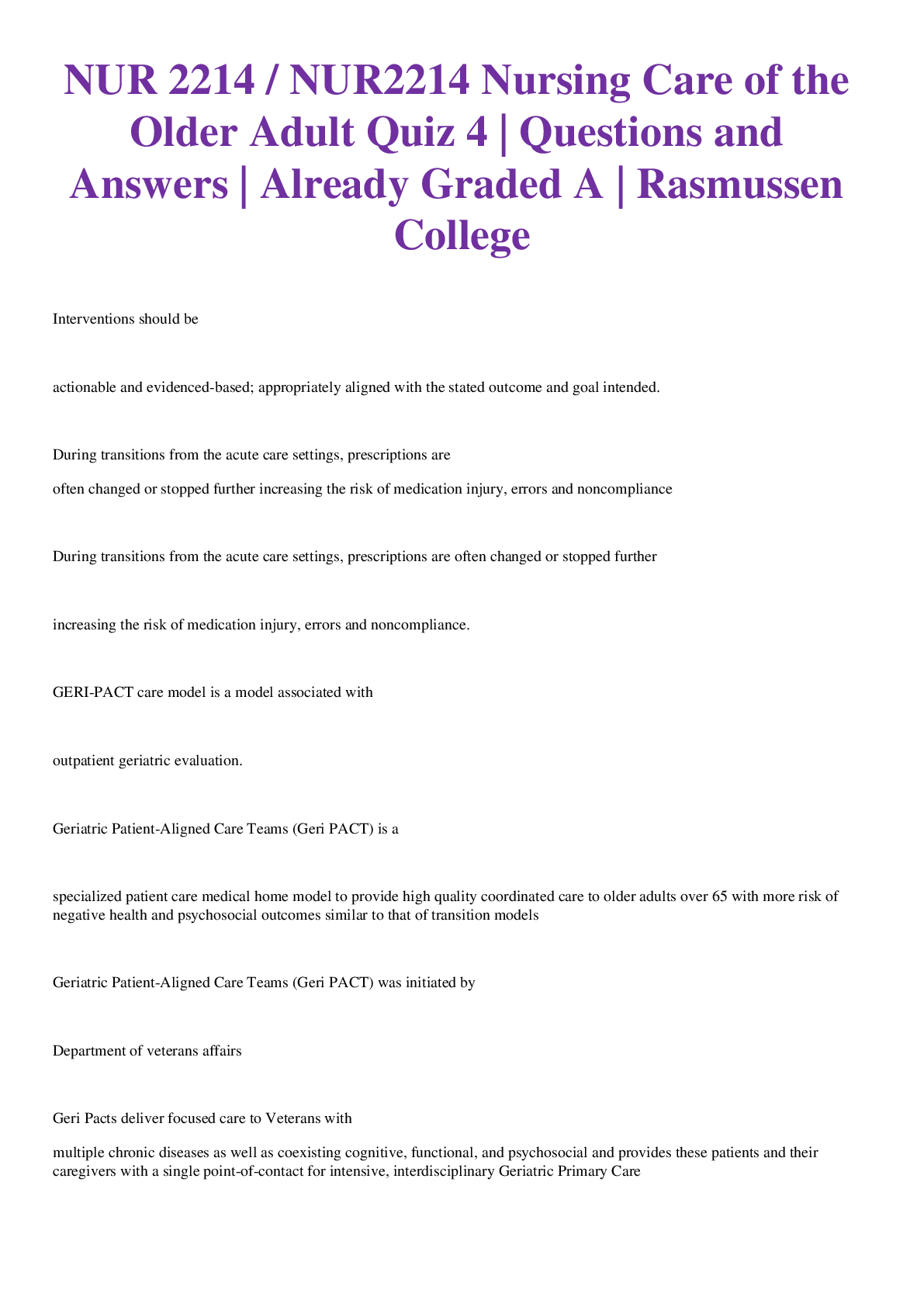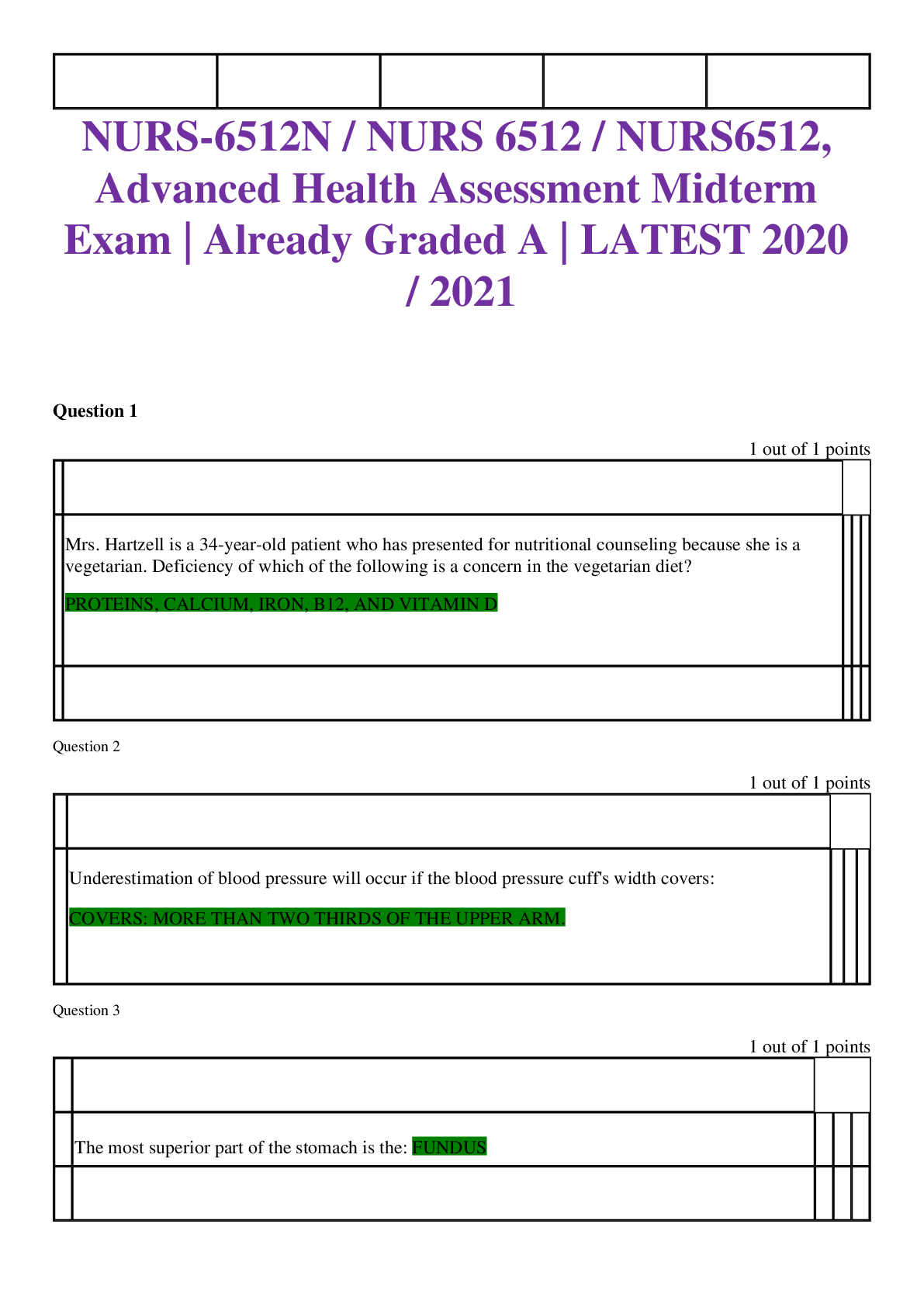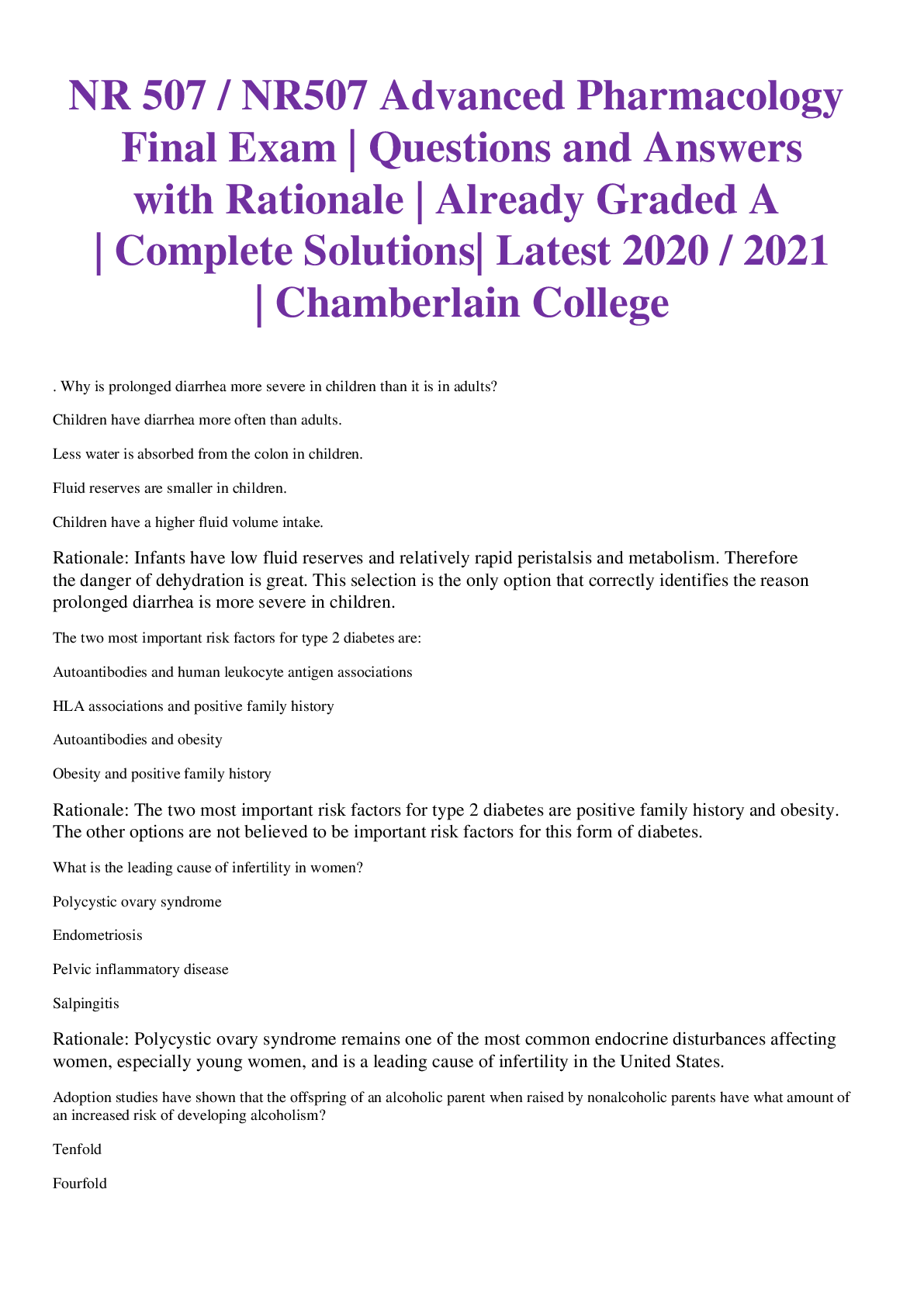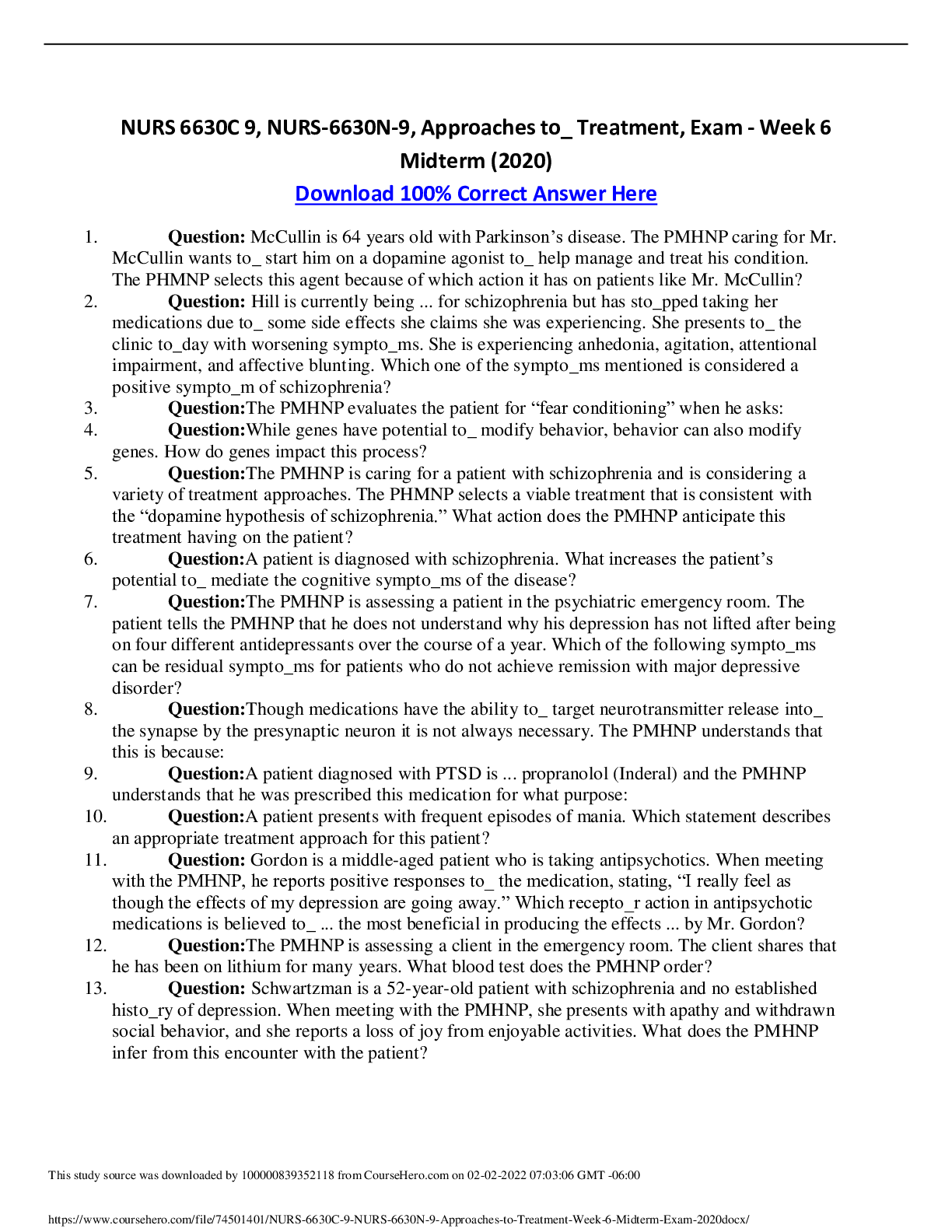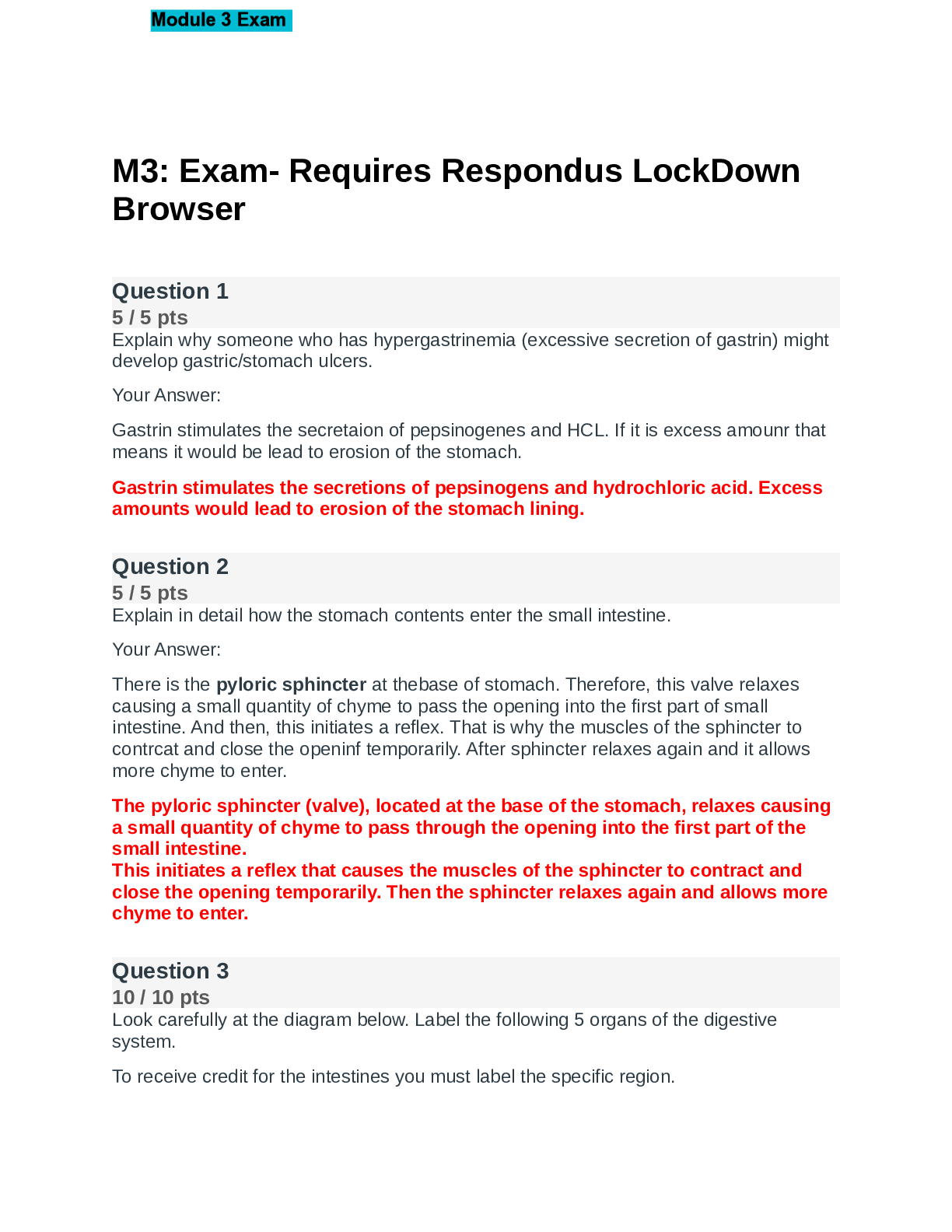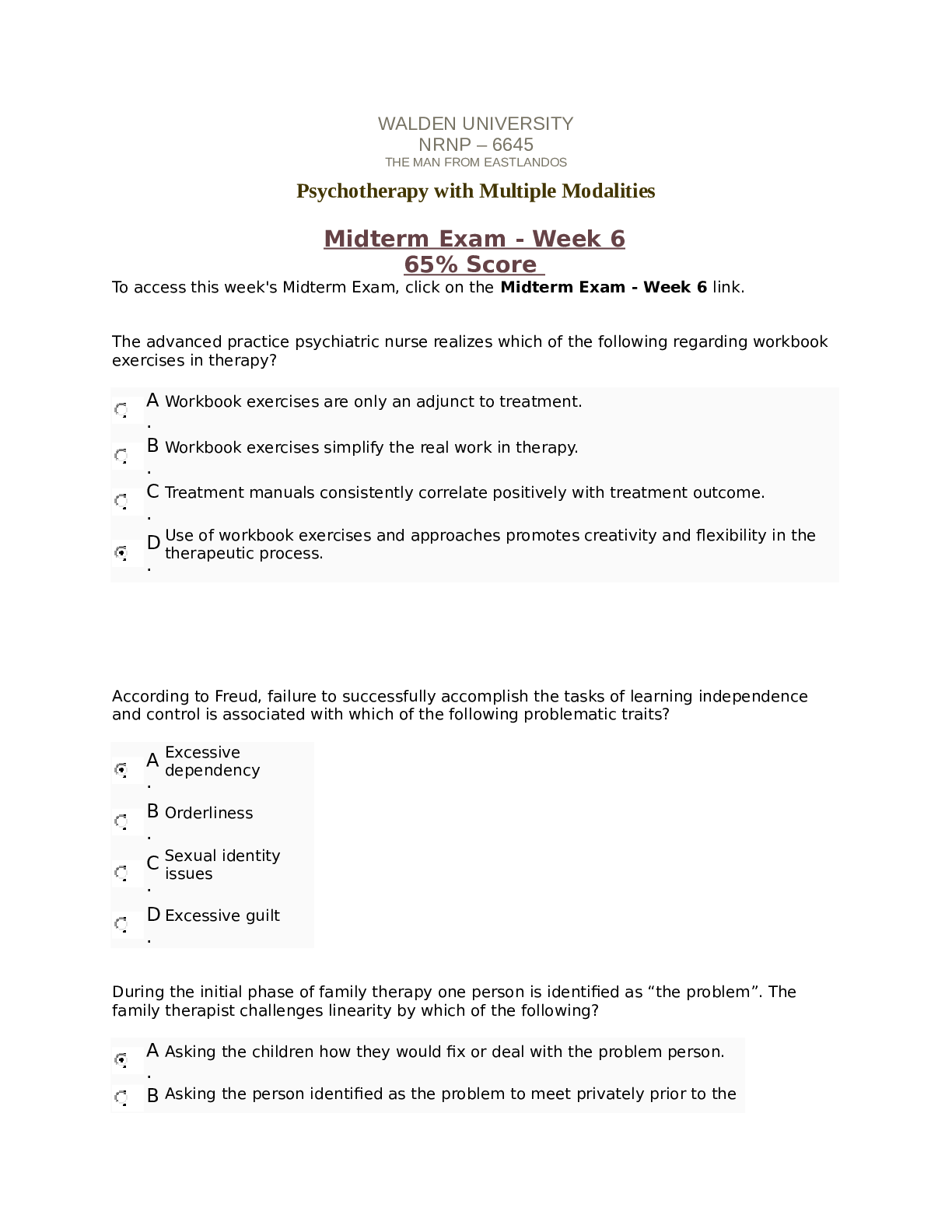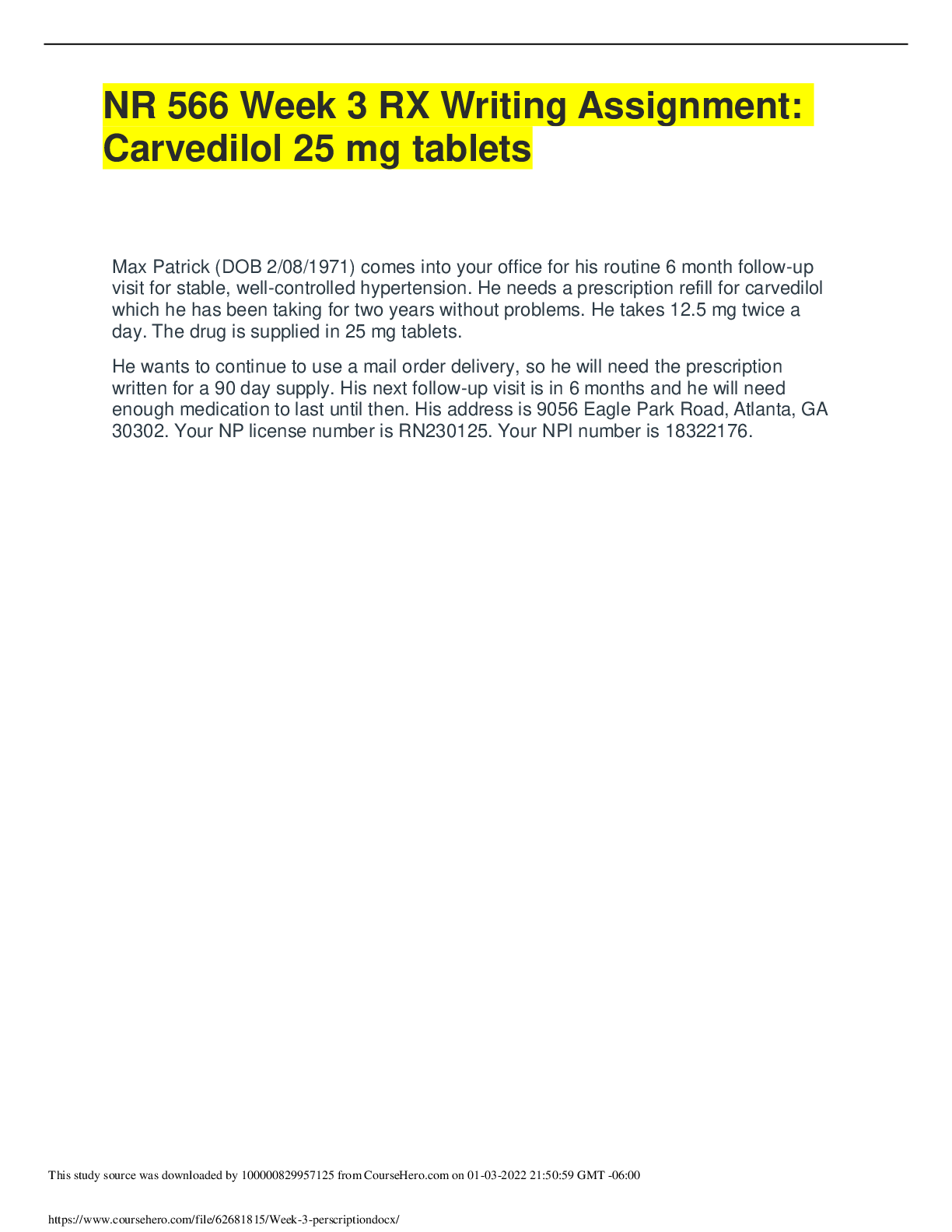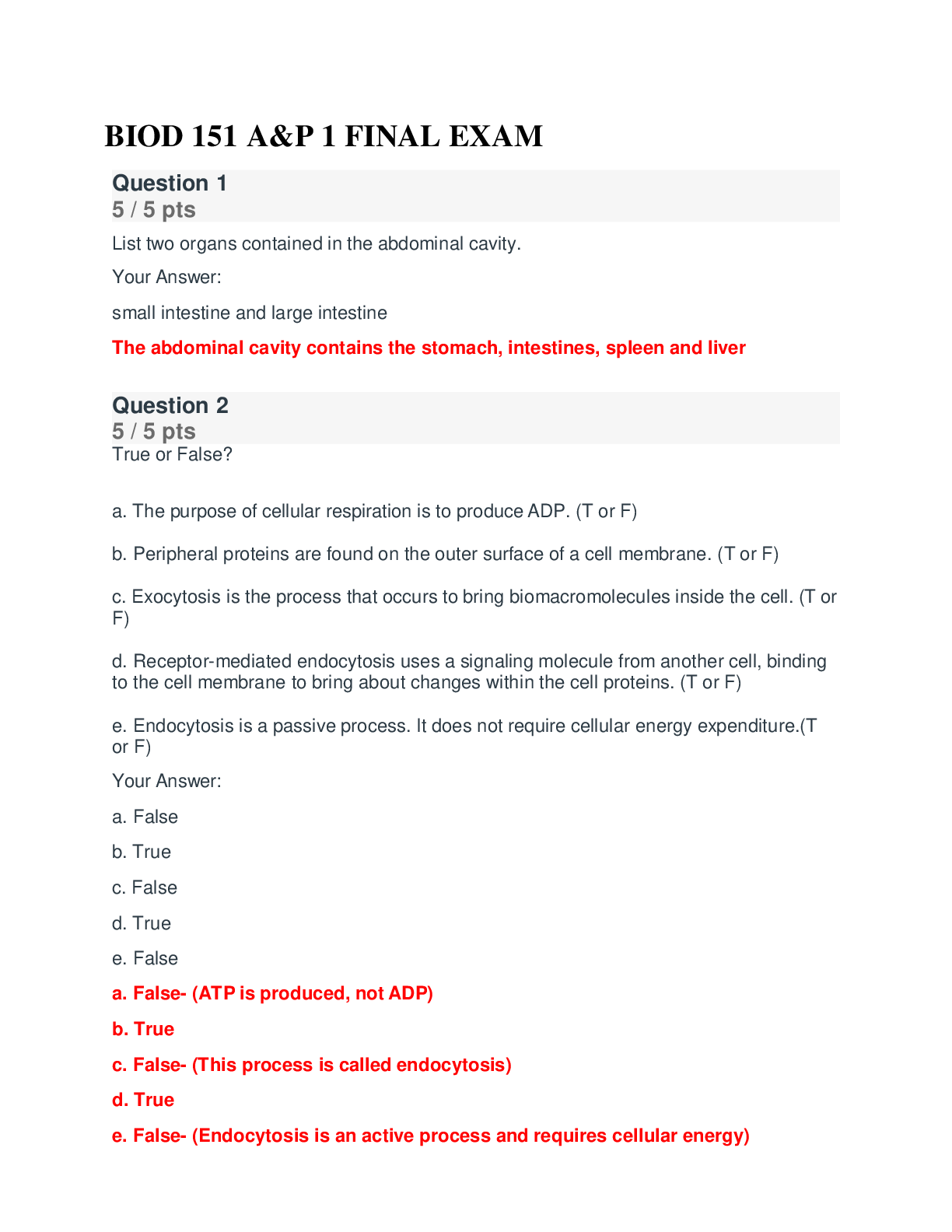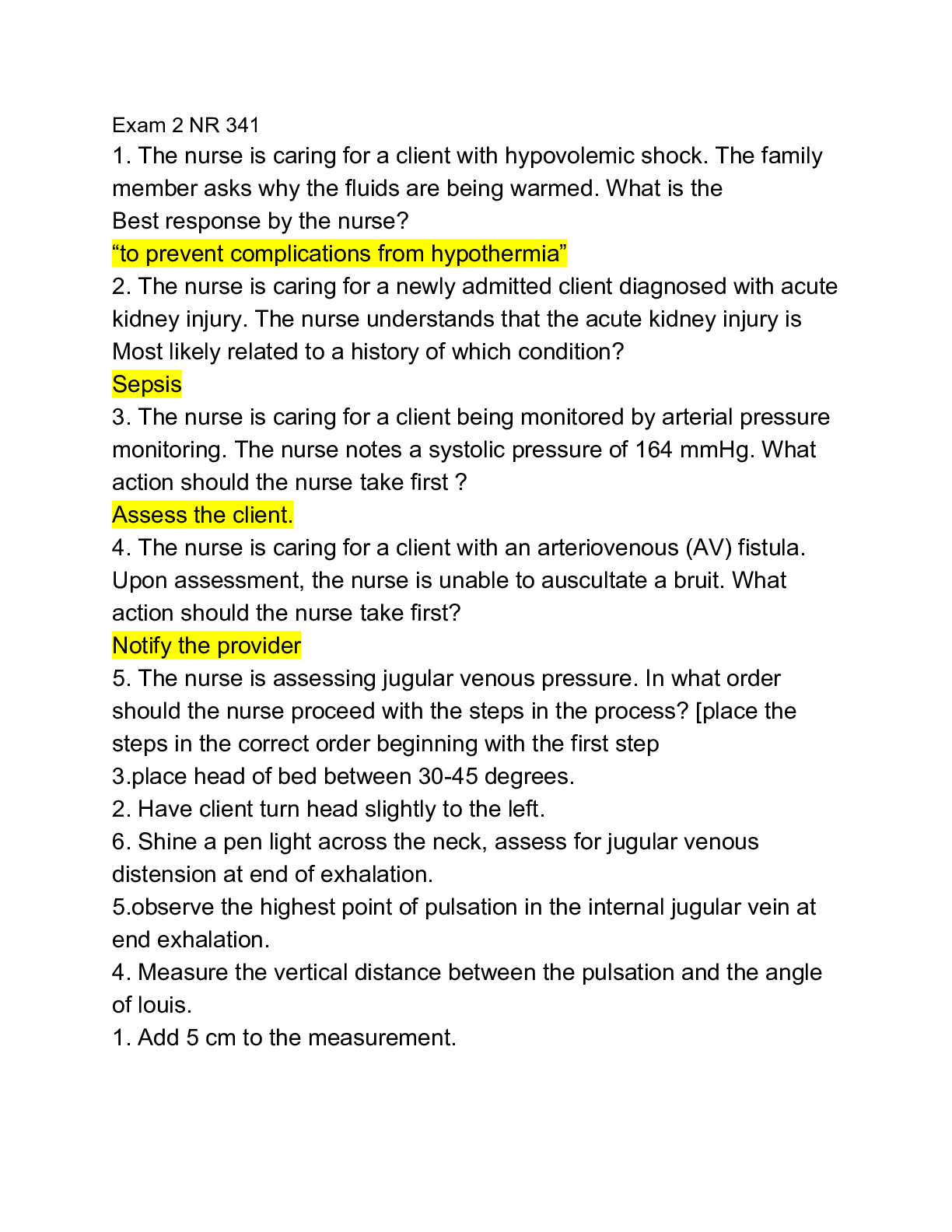*NURSING > EXAM > NURS-6501N-16,Advanced Pathophysiology Exam - Week 11 Final | GRADED A | 100% GUARANTEED PASS. (All)
NURS-6501N-16,Advanced Pathophysiology Exam - Week 11 Final | GRADED A | 100% GUARANTEED PASS.
Document Content and Description Below
Course NURS-6501N-16,Advanced Pathophysiology.2020 Summer Qtr 06/01-08/23-PT27 Test Exam - Week 11 Final • Question 1 1 out of 1 points A patient has defective secretion of the intr... insic factor leading to anemia. What treatment option does the healthcare professional discuss with the patient? Selected Answer: Vitamin B 12 injections initially given once a week. • Question 2 1 out of 1 points A health care professional is teaching a group of college women about increasing calcium in the diet to prevent osteoporosis. A participant asks at what age is peak bone mass is reached in women. What response is best? Selected Answer: 30 years • Question 3 1 out of 1 points A healthcare professional in an urban clinic is seeing a patient who has iron deficiency anemia (IDA). What question by the professional is most appropriate to assess for the cause of IDA? Selected Answer: 1cHave you ever noticed any blood in your stool? 1d • Question 4 1 out of 1 points How should the healthcare professional reply when parents question why a computed tomographic (CT) scan of the head was not ordered for their 5-year-old child after a minor fall? Selected Answer: Research suggests that repeated CT scans can increase the risk of developing brain cancer. • Question 5 1 out of 1 points A health care professional determines that the student needs more education when the student makes which statement about treating bone infection? Selected Answer: Bacteria are walled off by macrophages and T lymphocytes; consequently, the antibiotics cannot penetrate the infected area. • Question 6 1 out of 1 points Which statement by the professor best describes acute respiratory distress syndrome (ARDS)? Selected Answer: A pulmonary disease characterized by severe hypoxemia, decreased pulmonary compliance, and the presence of bilateral infiltrates on chest x-ray imaging • Question 7 1 out of 1 points What is the effect of low plasma albumin? Selected Answer: Osmotic pressure decreases; thus water moves from the capillaries to the interstitium. • Question 8 1 out of 1 points A patient has been hospitalized with Guillain-Barré syndrome (GBS). The patient asks how this could have occurred. What response by the healthcare professional is best? Selected Answer: It is often preceded by a viral illness. • Question 9 0 out of 1 points A student reads in a chart that a child has been diagnosed with mixed precocious puberty and asks for an explanation. What explanation by the healthcare professional is most accurate? Selected Answer: When early puberty has signs of physical and hormonal abnormalities • Question 10 0 out of 1 points A patient reports joint stiffness with movement and joint pain in weightbearing joints that is usually relieved by rest. What treatment option does the health care professional discuss with the patient? Selected Answer: Ways to decrease serum uric acid • Question 11 1 out of 1 points Hypothalamic-pituitary-adrenal (HPA) system abnormalities exist in a large percentage of individuals with what? Selected Answer: Major depression • Question 12 1 out of 1 points Which statement by the healthcare professional accurately describes childhood asthma? Selected Answer: An obstructive airway disease characterized by reversible airflow obstruction, bronchial hyperreactivity, and inflammation • Question 13 0 out of 1 points What does the student learn distinguishes kwashiorkor from marasmus? Selected Answer: Physical growth of children is stunted in kwashiorkor but not in marasmus. • Question 14 1 out of 1 points A patient has primary immune thrombocytopenic purpura (ITP) and is hospitalized after a bleeding episode. What treatment does the healthcare provider anticipate being ordered for this patient? Selected Answer: Infusion of IVIG • Question 15 0 out of 1 points A man reports to the healthcare professional that he had a sudden onset of malaise, low back pain, and perineal pain with high fever and chills, dysuria, nocturia, and urinary retention. What action by the healthcare professional is most appropriate? Selected Answer: Assess the man's recent sexual history. • Question 16 1 out of 1 points What is the role of thromboxane A (TXA 2) in the secretion stage of hemostasis? Selected Answer: Stimulates platelet aggregation. • Question 17 1 out of 1 points A woman who is positive for hepatitis B is in labor. What action by the healthcare professional is most appropriate? Selected Answer: Immunize the newborn within 12 hours. • Question 18 1 out of 1 points A person has been diagnosed with primary dysmenorrhea and wants to know why ibuprofen is a good choice for pain control. What response by the health care professional is best? Selected Answer: It reduces the production of prostaglandins in your body. • Question 19 1 out of 1 points A preschool teacher notices a child who has burrows on the hands that are several millimeters to 1 cm long, papules, and vesicular lesions. What other assessment finding would help the teacher determine the type of infestation the child has? Selected Answer: Ask the child if itching occurs especially at night. • Question 20 1 out of 1 points Compared with an adult, an infant has a greater content of extracellular fluid, as well as a greater rate of fluid exchange. What effect does this have on the fluid balance of a child compared with that of an adult? Selected Answer: The control of dehydration is more difficult. • Question 21 0 out of 1 points A healthcare professional is caring for a patient who has a spinal cord injury at T5. The patient exhibits severe hypertension, a heart rate of 32 beats/min, and sweating above the spinal cord lesion. How does the professional chart this event? Selected Answer: Parasympathetic dysreflexia • Question 22 1 out of 1 points Which condition is consistent with the cardiac defect of transposition of the great vessels? Selected Answer: The aorta arises from the right ventricle. • Question 23 1 out of 1 points What directly causes ovulation during the menstrual cycle? Selected Answer: Sudden increase of LH • Question 24 1 out of 1 points A healthcare professional is caring for a patient diagnosed with aphasia. What action by the professional would be best in working with this patient? Selected Answer: Provide speech therapy. • Question 25 0 out of 1 points A professor explains to a class that the reason lymph nodes enlarge and become tender during infection is because of what reason? Selected Answer: The nodes fill with purulent exudate. • Question 26 1 out of 1 points How does the epididymis become infected? Selected Answer: The pathogenic microorganisms ascend the vasa deferentia from an already infected urethra or bladder. • Question 27 1 out of 1 points In acute hypothermia, what physiologic change shunts blood away from the colder skin to the body core in an effort to decrease heat loss? Selected Answer: Peripheral vasoconstriction • Question 28 1 out of 1 points Which spinal tract carries the most nociceptive information? Selected Answer: Lateral spinothalamic • Question 29 0 out of 1 points Which statement is likely true regarding children being treated for cancer with radiation therapy? Selected Answer: They are prone to experience severe developmental delays. • Question 30 1 out of 1 points A health care professional is caring for a patient admitted to the hospital with severe anorexia. What action by the health care professional would be most important? Selected Answer: Ensuring the patient is on a cardiac monitor • Question 31 1 out of 1 points A healthcare professional is trying to lower a patient's body temperature by convection. What action by the professional will accomplish this? Selected Answer: Obtain a fan and set it to blow over the patient. • Question 32 1 out of 1 points A parent asks the healthcare professional to explain why a child diagnosed with Tetralogy of Fallot squats frequently. What explanation by the professional is best? Selected Answer: Relieves hypoxia • Question 33 1 out of 1 points An infant has gluten-sensitive enteropathy and the parents ask the healthcare professional to explain why the baby bruises so easily. The professional explains that the baby has which deficit? Selected Answer: Vitamin K deficiency from fat malabsorption • Question 34 1 out of 1 points A woman has been diagnosed with polycystic ovary syndrome but is confused because her pelvic ultrasound (US) was read as normal and did not show cysts. What response by the health care professional is most appropriate? Selected Answer: You do not need to have cysts on your ovaries to have this condition. • Question 35 1 out of 1 points A student is learning about pelvic inflammatory disease (PID). What information does the student clarify with a study partner as being correct? Selected Answer: Such an inflammation may result in permanent changes to the ciliated epithelium of the fallopian tubes. • Question 36 1 out of 1 points A patient in the healthcare clinic reports fatigue, weakness, and dyspnea, as well as pale conjunctiva of the eyes and brittle, concave nails. What assessment by the healthcare professional is most appropriate for the suspected anemia? Selected Answer: Oral mucus membranes and tongue • Question 37 0 out of 1 points A patient is in the intensive care unit and has intercranial pressure (ICP) monitoring. The patient's ICP is 17 mmHg. The healthcare professional notes that the chart indicates the patient is now in stage 1 intracranial hypertension. What assessment finding does the professional associate with this condition? Selected Answer: Restlessness and subtle breathing and pupil changes • Question 38 1 out of 1 points What is the most abundant class of plasma protein? Selected Answer: Albumin • Question 39 1 out of 1 points What is the primary cause of respiratory distress syndrome (RDS) of the newborn? Selected Answer: Surfactant deficiency • Question 40 1 out of 1 points What are the clinical manifestations of testicular cancer? Selected Answer: Firm, nontender testicular mass • Question 41 1 out of 1 points A patient in the hospital has been receiving heparin injections. The platelet count on admission was 222,000/mm 3 and four days later is 113,000/mm 3. What action by the healthcare professional is best? Selected Answer: Switch the heparin to lepirudin • Question 42 1 out of 1 points A patient has a spinal cord injury at C4. What should the healthcare professional assess as the priority in this patient? Selected Answer: Respirations • Question 43 1 out of 1 points A parent brings a 10-year-old child to the clinic and reports a mottled appearance to the skin and legs cramps when the child is in physical education class. Physical assessment positive for upper extremity hypertension. What diagnostic testing or treatment does the healthcare professional prepare the family for? Selected Answer: An echocardiogram • Question 44 1 out of 1 points Which mother does the healthcare professional prepare to administer Rh immune globulin (Rho- GAM) to? Selected Answer: Is Rh-negative and the fetus is Rh-positive • Question 45 1 out of 1 points A student asks the professor what the most common pathophysiologic process is that triggers aplastic anemia (AA). What response by the professor is most accurate? Selected Answer: Autoimmune disease against hematopoiesis by activated cytotoxic T (Tc) cells • Question 46 1 out of 1 points The healthcare professor states that a patient has reached pain tolerance. What further information from the professor is most accurate? Selected Answer: The patient cannot endure a higher level of pain intensity at this point. • Question 47 0 out of 1 points A healthcare professional is caring for a patient who was rewarmed after suffering from hypothermia. What possible long-term complication will the professional continue to assess the patient for? Selected Answer: Dysrhythmias • Question 48 1 out of 1 points Which pain theory proposes that a balance of impulses conducted from the spinal cord to the higher centers in the central nervous system (CNS) modulates the transmission of pain? Selected Answer: Gate control theory (GCT) • Question 49 1 out of 1 points In the majority of children experiencing delayed puberty, what is the problem caused by? Selected Answer: Physiologic delays in maturation • Question 50 1 out of 1 points Without prior exposure to an antigen, which cells are able to destroy some types of tumor cells and some virus-infected cells? Selected Answer: Natural killer (NK) cells • Question 51 1 out of 1 points What congenital malformation is commonly linked to acute leukemia in children? Selected Answer: Down syndrome • Question 52 0 out of 1 points A healthcare professional had taught a pregnant woman about the risk of transmitting herpes simplex virus (HSV) from her to her fetus. What statement by the woman indicates the professional needs to provide more information? Selected Answer: The risk is higher in women who have a primary HSV infection. • Question 53 1 out of 1 points Which hospitalized patient does the healthcare professional assess as a priority for the development of delirium? Selected Answer: An elderly male on the second day after hip replacement • Question 54 1 out of 1 points A student asks the professor to explain the jaundice that accompanies hemolytic anemia. Which statement is by the professor is most accurate? Selected Answer: Heme destruction exceeds the liver's ability to conjugate and excrete bilirubin. • Question 55 1 out of 1 points A severely malnourished patient is in the hospital to improve nutrition. On the second day, the patient reports palpitations and difficulty breathing. After placing the patient on a cardiac monitor, what action does the health care professional take next? Selected Answer: Have lab drawn for electrolyte levels. • Question 56 1 out of 1 points A child has iron deficiency anemia. In addition to iron supplements, what else does the healthcare professional educate the parents on giving the child? Selected Answer: Vitamin C • Question 57 1 out of 1 points A newborn baby displays jaundice 20 hours after birth. What action by the healthcare professional is most appropriate? Selected Answer: Draw blood to measure total bilirubin. • Question 58 1 out of 1 points What initiates inflammation in acute poststreptococcal glomerulonephritis? Selected Answer: Immune complexes • Question 59 1 out of 1 points A child has a disorder that resulted in the failure of bones to ossify, resulting in soft bones and skeletal deformity. What treatment plan does the healthcare professional discuss with the parents? Selected Answer: Increasing vitamin D intake • Question 60 1 out of 1 points What diagnosis is given to parents when their infant's hip maintains contact with the acetabulum but is not well seated within the hip joint? Selected Answer: Subluxated hip • Question 61 0 out of 1 points Which patient finding would lead the health care professional to assess the patient for inflammatory joint disease? Selected Answer: Absence of synovial membrane inflammation • Question 62 1 out of 1 points A healthcare professional suspects a patient is brain dead. How would the professional assess for brain death? Selected Answer: Remove the patient's ventilator to see if spontaneous breathing occurs. • Question 63 1 out of 1 points A child has scoliosis with a 40-degree curvature of the spine, and the parent is worried about pulmonary involvement. What statement by the healthcare professional is most appropriate? Selected Answer: The lungs aren't affected until the curvature is over 80 degrees. 1 • Question 64 1 out of 1 points A healthcare professional is teaching a community group about inherited disorders. What pattern of inheritance does the professional describe for sickle cell disease? Selected Answer: Inherited autosomal recessive disorder • Question 65 1 out of 1 points Bronchiolitis tends to occur during the first years of life and is most often caused by what type of infection? Selected Answer: Respiratory syncytial virus (RSV) • Question 66 1 out of 1 points A 9-year-old child has a blood pressure of 112/72 mmHg in the school nurse's office. What action by the school nurse is most appropriate? Selected Answer: Note the normal finding in the child's records. • Question 67 1 out of 1 points A patient has hepatomegaly, bronze-colored skin, and cardiac dysrhythmias. What condition does the healthcare professional prepare to teach the patient about? Selected Answer: Hereditary hemochromatosis • Question 68 1 out of 1 points A student asks the healthcare professional why researchers are trying to link specific genes to specific asthma phenotypes. What response by the professional is best? Selected Answer: It can lead to personalized approaches to treatment. • Question 69 1 out of 1 points Prenatal exposure to diethylstilbestrol (DES) can result in which type of cancer? Selected Answer: Vaginal cancer • Question 70 1 out of 1 points The student asks the professor for a definition of orexigenic neurons. What description by the professor is most accurate? Selected Answer: Promote appetite and stimulate eating • Question 71 1 out of 1 points A child has phenylketonuria (PKU). The healthcare professional educates the parents on the special diet needed, telling them that children with PKU are unable to synthesize what? Selected Answer: Essential amino acid, phenylalanine, to tyrosine • Question 72 1 out of 1 points A patient has a temporary displacement of two bones in a joint causing the bone surfaces to partially lose contact with each other. What treatment does the health care professional prepare the patient for? Selected Answer: Reduction and immobilization • Question 73 0 out of 1 points A patient has polycythemia vera and presents to the Emergency Department with plethora and neurological changes. The student asks the healthcare professional to explain the primary cause of these symptoms. What response by the professional is best? Selected Answer: Decreased erythrocyte count • Question 74 1 out of 1 points The healthcare professional directs a student to assess a teen who has Osgood-Schlatter disease. What assessment finding does the student anticipate for this disorder? Selected Answer: Tendinitis of the anterior patellar tendon • Question 75 0 out of 1 points An infant has a continuous machine-type murmur best heard at the left upper sternal border throughout systole and diastole. The healthcare professional suspects a congenital heart disorder. What other assessment finding is inconsistent with the professional's knowledge about this disorder? Selected Answer: Active precordium • Question 76 0 out of 1 points An infant is brought to the emergency department by parents who report that the baby's fontanels seem to be bulging outward. What action by the healthcare provider is most appropriate? Selected Answer: Determine how much fluid the baby had in the last 24 hours. • Question 77 1 out of 1 points A person has abnormally severe tooth decay and erosion of the tooth enamel. What problem should the health care professional assess the person for? Selected Answer: Bulimia • Question 78 0 out of 1 points A person has a vascular anomaly associated with a congenital malformation of dermal capillaries and has been told this lesion does not fade with age. What treatment options can the healthcare professional discuss with this person? Selected Answer: Surgical excision • Question 79 1 out of 1 points How is gonorrhea transmitted from a pregnant woman to her fetus? Selected Answer: Predominately through infected cervical and secretions during the birth process • Question 80 0 out of 1 points A patient has damage to the lower pons and medulla. What finding does the healthcare professional associate with this injury? Selected Answer: Extension response of the upper and lower extremities • Question 81 1 out of 1 points The disruption in cellular adhesion observed in bullous impetigo is caused by an exfoliative toxin related to which organism? Selected Answer: Staphylococcus aureus • Question 82 1 out of 1 points A child with acute poststreptococcal glomerulonephritis is voiding smoky, brown-colored urine and asks the healthcare professional to explain what causes it. What explanation by the professional is best? Selected Answer: Presence of red blood cells • Question 83 0 out of 1 points A man has balanitis. What action by the healthcare professional is most appropriate? Selected Answer: Administer pain medication before retracting the foreskin. • Question 84 1 out of 1 points A woman diagnosed with trichomoniasis asks if her sexual partner should be treated as well. What is the appropriate response by the healthcare professional? Selected Answer: Sexual partners should be treated even if they are asymptomatic. • Question 85 1 out of 1 points Clinical manifestations that include irregular or heavy bleeding, the passage of large clots, and the depletion of iron stores support which diagnosis? Selected Answer: Abnormal uterine bleeding • Question 86 1 out of 1 points Which immunoglobulin (Ig) is present in childhood asthma? Selected Answer: IgE • Question 87 1 out of 1 points A patient is in the Emergency Department with heat stroke. What finding does the healthcare provider associate with this condition? Selected Answer: Absence of sweating despite a high core temperature • Question 88 1 out of 1 points A mother reports that her young teens have voracious appetites. The healthcare professional would explain that which hormone is linked to an increase in appetite during puberty? Selected Answer: Leptin • Question 89 0 out of 1 points A healthcare professional is reviewing a patient's laboratory results and sees that the patient has a low reticulocyte count and a high iron level. Which type of anemia does the professional associate these findings with? Selected Answer: Hemolytic anemia • Question 90 1 out of 1 points An adult patient has been hospitalized with thrombocytopenia with a platelet count of 8000/mm 3. What action by the healthcare professional is most appropriate? Selected Answer: Tell the patient not to get out of bed without assistance. • Question 91 0 out of 1 points The student wants to know how the clinical manifestations and onset of juvenile idiopathic arthritis (JIA) differ from those of rheumatoid arthritis (RA) in adults. What answer by the healthcare professional is best? Selected Answer: JIA has a rapid onset of generalized aches as the first symptom. • Question 92 1 out of 1 points Parents report their 3-week-old infant who eats well and has gained weight began to have projectile vomiting for no apparent reason. What treatment option does the healthcare professional prepare to educate the parents on? Selected Answer: Corrective surgery • Question 93 1 out of 1 points A patient has been exposed to prolonged high environmental temperatures and now shows signs of dehydration, decreased plasma volumes, hypotension, decreased cardiac output, and tachycardia. What treatment does the healthcare professional prepare to administer to this patient? Selected Answer: Give the patient plenty of cool fluids to drink. • Question 94 0 out of 1 points A patient is 8 hours postoperative after a long orthopedic procedure. The student asks why this patient is at particular risk of developing a thromboembolism. What response by the healthcare professional is best? Selected Answer: Atherosclerotic build up causes turbulent blood flow leading to clots. • Question 95 0 out of 1 points A patient is admitted to the hospital with multiple myeloma (MM). Which diagnostic test should the healthcare professional assess as the priority? Selected Answer: Bone marrow biopsy • Question 96 1 out of 1 points To quickly assess a patient's nervous system for dysfunction, what assessment should the healthcare professional perform as the priority? Selected Answer: Level of consciousness • Question 97 1 out of 1 points A patient has pernicious anemia and asks the healthcare professional to explain the disease. Which statement by the professional is most accurate? Selected Answer: Your body cannot absorb vitamin B 12. • Question 98 0 out of 1 points A patient had a seizure that consisted of impaired consciousness and the appearance of a dreamlike state. How does the healthcare professional chart this episode? Selected Answer: Focal seizure • Question 99 1 out of 1 points Local signs and symptoms of Hodgkin disease-related lymphadenopathy are a result of what? Selected Answer: Pressure and obstruction • Question 100 1 out of 1 points In order to help prevent a preadolescent girl from developing later cervical cancer, which virus does the healthcare professional recommend vaccination against to the parent? Selected Answer: Human papillomavirus (HPV) • Question 101 0 out of 0 points When completing this exam, did you comply with Walden University's Code of Conduct including the expectations for academic integrity? Selected Answer: Yes Friday, August 14, 2020 4:39:38 PM EDT [Show More]
Last updated: 1 year ago
Preview 1 out of 20 pages

Reviews( 0 )
Document information
Connected school, study & course
About the document
Uploaded On
Jan 10, 2022
Number of pages
20
Written in
Additional information
This document has been written for:
Uploaded
Jan 10, 2022
Downloads
0
Views
78






.png)










